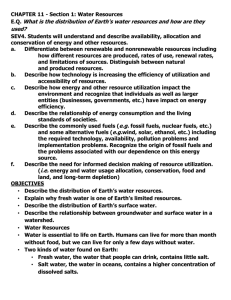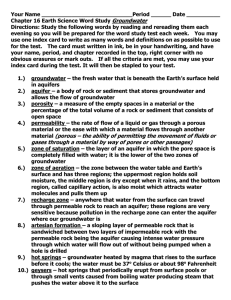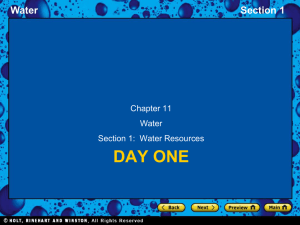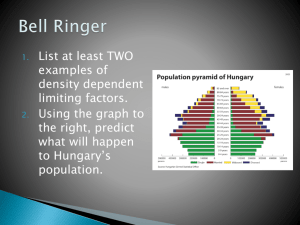Lesson 3
advertisement
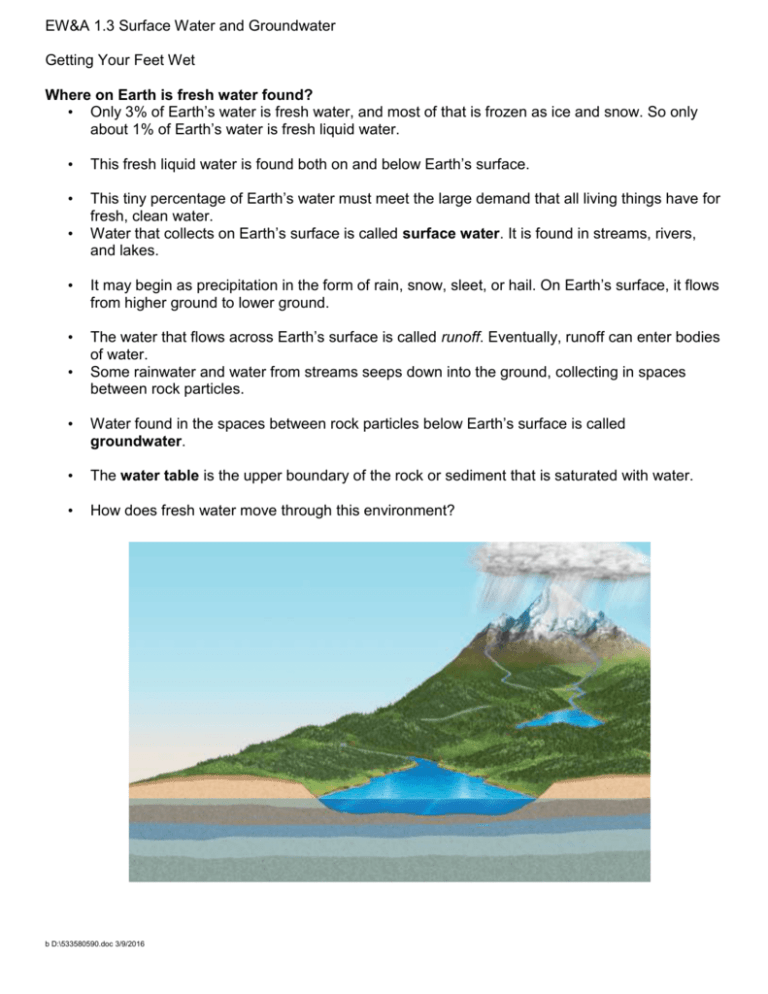
EW&A 1.3 Surface Water and Groundwater Getting Your Feet Wet Where on Earth is fresh water found? • Only 3% of Earth’s water is fresh water, and most of that is frozen as ice and snow. So only about 1% of Earth’s water is fresh liquid water. • This fresh liquid water is found both on and below Earth’s surface. • This tiny percentage of Earth’s water must meet the large demand that all living things have for fresh, clean water. Water that collects on Earth’s surface is called surface water. It is found in streams, rivers, and lakes. • • It may begin as precipitation in the form of rain, snow, sleet, or hail. On Earth’s surface, it flows from higher ground to lower ground. • The water that flows across Earth’s surface is called runoff. Eventually, runoff can enter bodies of water. Some rainwater and water from streams seeps down into the ground, collecting in spaces between rock particles. • • Water found in the spaces between rock particles below Earth’s surface is called groundwater. • The water table is the upper boundary of the rock or sediment that is saturated with water. • How does fresh water move through this environment? b D:\533580590.doc 3/9/2016 Cry Me a River How does water move on Earth’s surface? • Water trickling down a hillside may flow together to form a stream, eroding soil and rock to make a channel. • A channel is the path that a stream follows. Over time, the channel gets wider and deeper, as the stream erodes rock and soil. • Streams typically flow along weaknesses in bedrock. • A tributary is a smaller stream that feeds into a river and eventually into a river system. • • A river system is a network of streams and rivers that drains an area of its runoff. A watershed is the area of land drained by a river system. • Streams, rivers, flood plains, lakes, ponds, wetlands, and groundwater all contribute water to a watershed. • Watersheds are separated from one another by a ridge or an area of higher ground called a divide. Gradient is a measure of the change in elevation over a certain distance. In other words, it is a measure of the slope of the land. • • A river’s flow is the amount of water that moves through the river channel in a given amount of time. • Materials carried by a stream are called stream load. Rivers eventually deposit their stream loads downstream. Identify the tributary, river, divide, load, and watershed in the environment below. b D:\533580590.doc 3/9/2016 In Deep Water How does groundwater flow? • When water trickles down from the surface and reaches a rock layer with no pores or cracks, the water pools to form an aquifer. • An aquifer is a rock layer that stores groundwater and allows the flow of groundwater. • The water table can rise or fall depending on the amount of water in the aquifer. • An aquifer stores water in open spaces, or pores, between particles of rock or soil. • The storage space in an aquifer is measured by porosity, which is the percentage of the rock that is composed of pore space. • • The greater the pore space is, the higher the porosity is. Permeability is a measure of how easily water can flow through an aquifer. • High permeability means that the pores in the aquifer are connected to one another, so that water can flow easily. • A useful aquifer has both high porosity and high permeability. Gauge the extent of porosity and permeability (high or low) in each image. • The process by which surface water trickles down and enters an aquifer is called recharge. It occurs in an area called the recharge zone. • The process by which groundwater becomes surface water is called discharge and happens in discharge zones. b D:\533580590.doc 3/9/2016 • • Through discharge and recharge, the same water circulates between surface water and groundwater. Label the discharge and recharge zones of the aquifer. Making a Splash How do people use surface water and groundwater? • In a typical home, about 50% of all water used is for washing clothes, bathing, washing dishes, and flushing toilets. • About 33% is used to water lawns and gardens. The rest is used for drinking, cooking, and washing hands. • In the United States, about 40% of fresh water is used for agricultural activities like growing crops and raising livestock. • About 45% of the fresh water used in the United States is used for industry. • Surface water in rivers, streams, and lakes is used to transport products and people, and for various recreational activities. Troubled Waters • The limited supply of fresh water must be managed to meet the demands of a growing population. • Scientists estimate that about 1 billion people around the world do not have an adequate supply of clean, fresh water. • Scientists are developing technologies to obtain clean, fresh water to meet global needs. b D:\533580590.doc 3/9/2016


